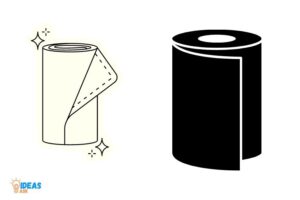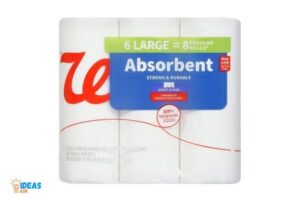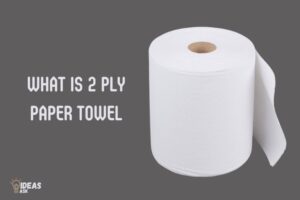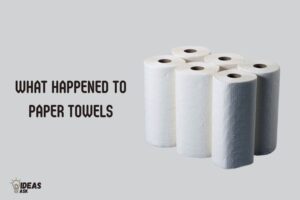Comb What Do Nits Look Like on Paper Towel
Nits on paper towels look like small, yellowish-brown, oval-shaped eggs. Nits are typically found in the hair and attach themselves to individual strands near the roots.
They can be difficult to remove and require treatment to eliminate. Nits are a common problem for many people, particularly children. They are often spread through direct contact with someone who has them, or by sharing combs, brushes, or hats.
Nits may also be present in bedding, clothing, and other fabrics. If left untreated, they can lead to itching, redness, and discomfort. It is important to learn how to identify nits and take steps to eliminate them to prevent further infestations.
Understanding The Basics Of Nits And Lice
If you’re a parent, you’re likely familiar with lice. These tiny parasites are a problem for many children and their families. Nits are lice eggs and can be difficult to spot. Understanding the basics of nits and lice can help you identify them early and take steps to get rid of them.
Differentiating Between Lice And Nits
It’s important to differentiate between lice and nits. Lice are tiny insects that live on the scalp and hair. Nits, on the other hand, are tiny, oval-shaped eggs that are attached to the hair shaft. Here are a few key points to remember:
- Lice are often gray or tan.
- Nits are yellow or white and are less than a millimeter in length.
- Lice move quickly and can be hard to see.
- Nits may be easier to spot, especially if you part the hair and shine a light on the scalp.
The Life Cycle Of Lice And Nits
Lice and nits have a unique life cycle that you should understand. Female lice lay nits, which then hatch into small nymphs. These nymphs grow into adult lice and the cycle begins again. Here are a few things to keep in mind:
- Female lice can lay up to six nits a day.
- It takes about one to two weeks for nits to hatch.
- It takes about seven days for nymphs to grow into adult lice.
- Adult lice can live for up to 30 days on a person’s scalp.
How Nits Stick To Hair And Other Surfaces
One of the things that make nits so difficult to remove is their ability to stick to hair and other surfaces. Here’s what you need to know:
- Nits are attached firmly to the hair shaft with a glue-like substance.
- This substance makes it difficult to remove nits with a comb or shampoo.
- Nits can also stick to other surfaces, such as clothing and bedding, making it important to wash and dry these items at high temperatures.
Nits and lice can be a problem for children and their families. However, by understanding the basics of nits and lice, you can identify them early and take steps to get rid of them. Remember to differentiate between lice and nits, understand their life cycle, and be aware of how nits stick to hair and other surfaces.
Why Identifying Nits Is Crucial
Lice infestation is a common problem, especially in households with young children. Identifying nits is crucial because they are a sure sign of lice infestation. Here are some reasons why identifying nits is important.
- The risks of ignoring an infestation: If left untreated, a lice infestation can spread rapidly, making it challenging to eliminate. Moreover, it can lead to several other health complications such as bacterial infections due to constant itching and scratching.
- How to prevent the spread of lice: Identifying nits early on and starting treatment can help prevent the spread of lice. This involves taking individual precautions such as not sharing hairbrushes, combs, hats or any other personal items with others.
- The effect of nits on personal health and hygiene: Nits make it impossible to maintain personal hygiene. Therefore, identifying them early on can save a lot of time and effort as it can be dealt with swiftly.
The Risks Of Ignoring An Infestation
Ignoring an infestation can lead to several complications, such as:
- Incessant itching: Lice bites can cause considerable itching making it difficult for children to focus on work and other daily activities.
- Skin infections: Constant scratching can cause bacterial infections like impetigo, a highly infectious skin condition that can spread quickly in crowded areas.
- Loss of sleep: Itchiness caused by lice bites can keep children from getting enough rest, leading to fatigue, irritability and poor performance at school.
How To Prevent The Spread Of Lice
Preventing the spread of lice infestation requires concerted effort, and starting with the following steps can help:
- Educate children: It is vital to teach children about the importance of using designated combs, hats, and other personal items to avoid the spread of lice.
- Keep the home and personal items clean: Frequent cleaning of your home, personal items and laundry is another effective way to prevent the spread of lice.
- Identify and treat lice early: As soon as you suspect a lice infestation, start treatment right away to prevent it from spreading to others.
The Effect Of Nits On Personal Health And Hygiene
Nits are not just embarrassing; they can also affect a person’s personal health and hygiene. Here’s how:
- Spread of infections: Nits and lice thrive in unhygienic environments, so their presence can lead to the spread of other infections like ringworm and scabies.
- Constant itchiness: Nits cause itchiness, making it difficult to focus on work and other daily activities.
- Social embarrassment: Having nits can lead to social embarrassment, especially for school-going children.
Identifying nits is crucial in dealing with lice infestations, preventing their spread, maintaining personal hygiene and, most importantly, avoiding possible complications. Regular checks, cleanliness, and starting treatment at the earliest can go a long way in keeping lice infestations at bay.
The Benefits Of Using Paper Towels For Nits
When it comes to removing nits from hair, it can be a challenging and time-consuming task. Fortunately, paper towels can make the process a lot quicker and easier. Here are some of the benefits of using paper towels for nits:
Absorbency
Paper towels are highly absorbent, which makes them ideal for removing nits from hair. The absorbent material allows the towel to soak up any excess water, making it easier to spot the nits and remove them.
- Paper towels absorb excess water, making it easier to see and remove nits.
- The absorbent material allows the towel to grip onto nits, helping to remove them from the hair.
Visibility
Nits can be difficult to see, especially in dark or thick hair. However, paper towels can help to increase visibility, making it easier to spot and remove the nits.
- The white color of most paper towels contrasts against the hair, making any nits more visible.
- The smooth surface of the paper towel helps to reflect light, further increasing visibility.
Convenience
Paper towels are a convenient option for removing nits, especially if you don’t have access to a lice comb. They are widely available and can be easily disposed of after use, reducing the risk of any further infestations.
- Paper towels are widely available at grocery and convenience stores.
- Used paper towels can be easily disposed of, reducing the risk of further infestations.
By using paper towels to remove nits, you can save time, increase visibility, and reduce the risk of further infestations. So why not give it a try and see the benefits for yourself?
What To Look For On Paper Towels
When checking for nits, it’s not uncommon to find yourself scrutinizing paper towels for signs of these pesky critters. But what, exactly, should you be looking for on your trusty towel? Here are some essential tips that will help you identify what nits look like on paper towels.
Texture And Color Differences Between Nits And Other Debris
To differentiate nits from other materials, keep an eye out for texture and color contrasts such as:
- Nits have a translucent, almost yellowish hue, whereas other debris may be opaque.
- Nits have an oval shape and a slightly flattened appearance, while other debris is usually round or irregularly shaped.
- Nits have a hard, shell-like texture, while other debris is typically softer or powdery.
By noting these differences, you’ll be better equipped to identify nits and avoid mistaking them for other things.
The Size And Shape Of Nits
Knowing how to recognize the size and shape of nits can also help you detect them. Here are some pointers to keep in mind:
- Nits are usually tiny, measuring about 0.8mm by 0.3mm, which is about the size of a grain of sand.
- Their shape is oval or tear drop and may be mistaken by dirt or debris.
- The length of their shape is from 0.5mm to 1.2mm.
Being armed with this information, you can conduct a precise search for any nits that may be present.
How To Verify Your Findings
Once you’ve identified what you think might be a nit, it’s essential to verify your findings. Here’s what you need to do:
- Use a lice comb to remove the supposed nit from the paper towel. If it’s challenging to remove, it’s likely to be a nit.
- Examine the nit under a bright light to see if there’s an ogre color coming off.
- Check the nit for a black or brown head as these may be dead nits, whereas a white or grey head indicates a live nit.
- In doubt, seek professional lice treatment service.
By following these steps, you’ll be able to confirm whether you’ve found a nit or not.
Overall, examining a paper towel for nits can be an effective way to detect an infestation early on. By familiarizing yourself with what nits look like and how to differentiate them from other debris, you’ll be better prepared to combat these unwelcome visitors.
What You Need To Get Started
Before you start combing for nits on paper towel, you need to have the right tools and materials. Here’s what you need to get started:
A Fine-Tooth Comb
The key tool you’ll need is a fine-tooth comb. Commonly known as a nit comb, it is specifically designed for removing nits and lice eggs from hair. Follow these key points:
- Look for a comb with close-set teeth, around 0.2mm apart, to ensure effective removal of nits.
- Metal combs are usually more effective than plastic ones, as they’re better at catching nits and can be sterilized.
- You should choose a comb with a long, narrow handle so it’s easy to grip and use, especially for long sessions of combing.
Other Tools To Consider
Besides a fine-tooth comb, you might also need other tools or materials to help with combing for nits. Consider the following:
- Magnifying glass: A magnifying glass helps you see the nits much better, as they can be small and difficult to see with the naked eye. It can also help identify them from dandruff or dirt.
- Bright light: A bright light is also helpful in seeing the nits. You can use a desk lamp or a flashlight to focus the light on the hair being combed.
- Gloves: Wearing gloves can help prevent the transfer of lice or nits from one individual to another. It can also protect your hands while combing.
Preparing The Hair For Combing
To get the most out of your combing session, you need to first prepare the hair. Here are some steps to follow:
- Shampoo hair: Before combing, shampoo the hair and rinse it thoroughly with warm water. Avoid using conditioner beforehand, as it can make it difficult to comb hair.
- Detangle hair: Use a wide-toothed comb or your fingers to detangle your hair, making sure there are no knots.
- Dry hair: Use a towel to dry hair and make sure there’s no excess moisture left, as it makes it difficult to comb through the hair.
Remember, to ensure effective removal of nits, repeat the combing process every few days, until no more nits are caught in the comb.
The Combing Process
If you want to effectively get rid of nits, combing is an essential process. Here are some key points to consider in this process:
- Use a fine-tooth comb to ensure that you remove every single nit from your hair.
- Start combing at the scalp and go downward. Make sure to go slowly so that you don’t miss any nits.
- Dip the comb in a bowl of water with soap after every pass to get rid of the nits.
Techniques To Effectively Remove Nits
There are various techniques to effectively remove nits from your hair. Here are some key points to consider:
- Use a magnifying glass to help you find nits that are too small to see with the naked eye.
- Use a vinegar solution to loosen the glue that attaches the nits to your hair.
- Consider using an electronic comb that targets and zaps lice and nits.
Proper Disposal Of Nits And Combing Tools
When it comes to disposing of nits and combing tools, it’s important to do it properly. Here are some key points to consider:
- Dispose of the nits and empty soapy water in a sealed plastic bag to ensure that they don’t spread.
- Wash combs and brushes with hot soapy water and leave them to air dry.
Frequency And Duration Of Combing Sessions
Combing sessions should be frequent enough to ensure that you remove all nits from your hair. Here are some key points to consider:
- Combing sessions should be done daily for at least one week after you detect lice or nits.
- Each session should last for at least 30 minutes to ensure that you’re thorough in removing all nits.
Combing is an important process in getting rid of nits. Use the right techniques, dispose of nits and tools properly, and conduct frequent and long enough combing sessions to effectively remove nits.
Issues Nits Can Cause For Adults
Nits, the eggs of head lice, can cause several issues for adults. If left untreated, they can cause discomfort and potentially lead to bigger problems.
Identifying And Treating Infestations
Knowing how to identify and treat nits infestations is essential. Here are some key points to consider:
- Nits are small, oval-shaped eggs that attach to individual hair strands.
- Adult head lice are tan or grey and about the size of a sesame seed.
- The most common symptom of head lice is intense itching on the scalp and neck.
- Over-the-counter treatments like shampoos and lotions are available, but prescription treatments may be necessary for severe cases.
- Comb out nits and lice with a fine-toothed comb or invest in electric combs to remove the infestation.
How To Prevent Future Infestations
Preventing the likelihood of future nits infestations is key. Here are some essential steps to take:
- Avoid sharing combs, brushes, and hair accessories with others.
- Do not share hats, helmets, or other headgear.
- Always wash bedding, towels, and clothing regularly in hot water.
- Vacuum carpeted areas and upholstered furniture frequently if anyone in the household has had head lice.
Nits And Workplace Implications
Head lice can impact the workplace, too. Here are some important considerations:
- Adults with head lice may need to stay home from work until the infestation is cleared.
- Employers can provide head lice education for employees to reduce the likelihood of workplace infestations.
- Maintain a clean office environment to prevent potential head lice outbreaks.
Remember that nits are a common problem that can affect anyone. Take preventative measures and seek help if you notice symptoms to reduce the likelihood of infestations.
Concerns For Children
Nits, or head lice eggs, are a common problem among children. Having nits can lead to social stigma, as well as discomfort and itching. As a parent or caregiver, it’s essential to understand how to address this issue with your child.
Here’s what you need to know:
How To Talk To Your Children About Nits
- Approach the topic calmly and without judgement. Let your child know that nits are a common issue, and that it’s nothing to be ashamed of.
- Explain what nits are and how they’re spread. Teach your child how to identify nits and lice, and let them know that it’s important to avoid sharing personal items such as combs and hats.
- Encourage your child to speak up if they notice symptoms or suspect they have nits. Let them know that you’re there to help and that it’s essential to prevent the spread of nits to others.
Dealing With Nits In Schools And Daycares
- Schools and daycares often have protocols in place for dealing with nits. Familiarize yourself with these protocols and follow them carefully if your child attends one of these institutions.
- Notify the school or daycare if your child has or has had nits. This will help prevent the spread of nits to others.
- Educate your child on good hygiene practices and the importance of not sharing personal items. Encourage them to wash their hands regularly and keep their belongings separate from others.
Nits And Social Stigma
- Unfortunately, there is a social stigma attached to having nits, which can lead to feelings of shame and embarrassment. As a parent or caregiver, it’s essential to address this stigma and let your child know that having nits is a common issue that can be easily treated.
- Teach your child that anyone can get nits and that they are not a reflection of personal hygiene or cleanliness. Help them understand that it’s important to take care of themselves and others and to avoid spreading nits to others.
- Maintain open and honest communication with your child and let them know that they can come to you with any concerns or questions they may have about nits.
Remember that having nits is a common issue among children and can be easily treated with the right precautions and treatments. By educating yourself and your child, you can help prevent the spread of nits and alleviate any feelings of shame or embarrassment.
Over-The-Counter Solutions For Nits And Lice
Head lice infestations can be a nightmare for parents and children alike. Fortunately, there are a variety of over-the-counter solutions available that can help treat these pesky parasites. Here are the key points to keep in mind when choosing an over-the-counter solution:
Success Rates And Potential Side Effects
- Not all over-the-counter treatments are created equal. Some are more effective than others, and some may have more potential side effects. Always read the labels carefully before choosing a product.
- Over-the-counter treatments typically contain pesticides that kill the lice. However, some lice have developed resistance to certain pesticides, which may affect the product’s success rate.
- Many over-the-counter treatments contain permethrin, a common pesticide. However, permethrin can cause skin irritation in some people. If you or your child has sensitive skin, look for treatments that are labeled as “gentle” or “sensitive.”
How To Choose The Best Product For Your Needs
- Take into consideration the age of the person being treated. Some products are not suitable for young children, so make sure to check the label for age restrictions.
- Consider the severity of the infestation. If the infestation is mild, a milder solution may suffice. However, if the infestation is severe, a stronger solution may be necessary.
- Look for all-in-one kits that come with a comb, as these can be more effective at removing both nits and lice.
- Consider the price and the amount of product in the package. While a more expensive treatment may seem daunting, it may be more effective and come with more product than a cheaper alternative.
Remember to always follow the instructions carefully for any over-the-counter treatment and to thoroughly comb the hair with a nit comb to remove any remaining nits and lice. With the right over-the-counter solution, you can tackle a head lice infestation head-on.
Seek Medical Treatment
When To Consult A Doctor
If you have tried treating nits with over-the-counter products or home remedies but they persist, it is time to see a doctor. Here are some circumstances that could prompt you to seek medical treatment:
- If you or your child has a severe infestation of lice and nits
- If other members of your household also have head lice
- If the over-the-counter treatments or home remedies are ineffective
- If you or your child have sores or scratching that lead to infection
- If you notice any unusual symptoms, such as swollen glands or a rash
A doctor may prescribe more potent treatments to get rid of nits and lice. They can also examine the scalp for any underlying conditions that may be causing the infestation.
Prescription Treatment Options
Prescription treatments for nits and lice are stronger than over-the-counter formulas. Here are some of the most common options:
- Prescription-strength permethrin: This insecticide kills nits and lice. It is available in lotion form and is applied to the hair and scalp for 10 minutes before washing it out.
- Malathion lotion: This alcohol-based insecticide is used when other treatments fail. It is applied to the hair and scalp and left on for 12 hours before washing it out.
- Benzyl alcohol lotion: This medication suffocates and kills nits and lice. It is applied to the hair and scalp for 10 minutes and then rinsed out.
Before recommending any treatment, your doctor will evaluate your medical history, the severity of the infestation, and any known allergies. Follow your doctor’s instructions carefully to ensure effective treatment.
Addressing Concurrent Skin Conditions
Nits and lice can lead to itchy scalp and skin irritation. It is important to manage any concurrent skin conditions that may arise from scratching. Consider the following remedies:
- Calamine lotion: This astringent lotion helps soothe itchy skin and can be applied topically to the affected areas.
- Cool compresses: Apply a cool, damp cloth to the itchy areas to alleviate pain and reduce swelling.
- Oatmeal baths: This remedy soothes irritated skin and reduces the urge to scratch. Add two cups of colloidal oatmeal to a tub of lukewarm water and soak for 15 minutes.
- Hydrocortisone cream: This anti-inflammatory cream can provide relief from itching. However, consult with a doctor before using it to ensure it’s safe for you.
If the itching persists or worsens, consult with your healthcare provider. In some cases, antibiotics or other medications may be required to manage skin irritation and infection caused by the infestation.
Frequently Asked Questions On Comb What Do Nits Look Like On Paper Towel
What Do Nits Look Like On A Paper Towel?
Nits on a paper towel look like tiny, whitish, and oval-shaped eggs that are firmly attached to the fibers.
How Do You Identify Nits On Paper Towel?
Nits are easily identifiable on paper towels because they are often clustered together and resemble small grains of sand.
Can You See Live Lice On A Paper Towel?
It is difficult to see live lice on a paper towel, as they move quickly and are smaller than nits.
How Do You Get Rid Of Nits On A Paper Towel?
To get rid of nits on a paper towel, you can dispose of the towel in a sealed plastic bag or wash it in hot water.
Conclusion
So, there you have it! Comb what do nits look like on paper towel and you’ll find that they are much easier to spot than you might think. By regularly using a nit comb and checking your child’s hair, you can help to prevent a full-blown head lice infestation.
Remember, you don’t always need to turn to chemicals or prescription treatments to get rid of nits. A simple comb and some patience can often do the trick. By following the tips and techniques outlined in this post, you can keep your family’s hair happy, healthy, and free from lice.
So, get to combing and say goodbye to those pesky nits for good!






